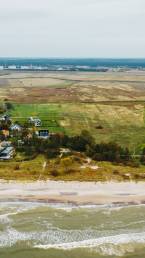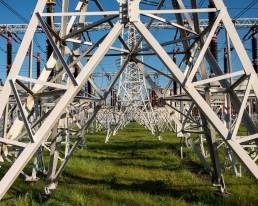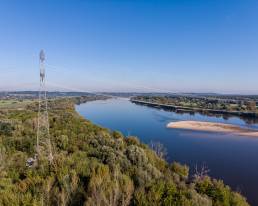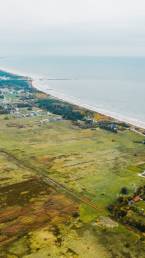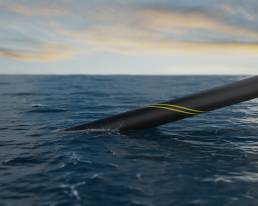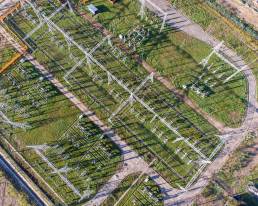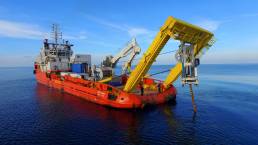ENVIRONMENT
Preparation
Construction of the interconnector
The Harmony Link will be approximately 330 km long, of which around 290 km will be the offshore part. The offshore link is a large and complex project, which is why it is being carefully prepared.
In the Baltic Sea, the electricity link will be built in the exclusive economic zones of Lithuania, Poland, and Sweden and in the territorial sea of Lithuania and Poland.
Every effort is made to minimize the impact on the environment and people when building, expanding, and modernizing electricity infrastructure.
Environmental impacts occur during the construction and operation phases of the project. Both noise and groundworks are confined to designated areas. The aim is to minimize the effects.
All electricity infrastructures are governed by strict national and EU rules. In addition, specially designated authorities check and ensure that standards for electric and magnetic fields and noise levels are not exceeded. The offshore grid is safe because it is tested before being laid on the seabed. The process is also monitored and controlled by underwater cameras from the ship, so the possibility of defects is minimal. The seabed is minimally impacted during the laying process as there is no intervention in the seabed. Prior to the construction of the interconnector, appropriate studies were carried out on the Cable Route including onshore and offshore part, The spatial planning and environmental impact assessment processes required for Harmony Link are also underway. When planning the construction of a interconnector on forest land, preference shall be given to forest land that is not covered by forest (logging sites, dead stands, forest squares) and where stands of trees that have been damaged or otherwise thinned by natural hazards have a low skewness. In all cases, the aim is to protect forests. When selecting the underground cable location, the route’s length and the number of turning points shall be optimized, and the number of lands to be cleared shall be minimized.
ENVIRONMENT
The evaluation of the effects on the environment
Environmental monitoring will be carried out during both the construction and operation of Harmony Link to avoid impacts on the natural and social environment.
The monitoring program shall consider the short- and long-term effects of the activities on environmental components, changes in environmental conditions, and the intrusion of the technological facility into the natural and urban landscape.
The first phase of monitoring focuses on assessing and preventing the impacts of construction activities. During the construction period, environmental impacts will arise from access facilities, movement of construction equipment, and the removal of trees and shrubs during construction. The construction of the underground cable will disturb the topsoil. The construction of the switchyard will alter the landscape and the topsoil.
The operation will also involve environmental monitoring, i.e. the systematic observation, assessment, and forecasting of changes in the state of the natural environment and its elements, as well as anthropogenic impacts.
Environmental monitoring during construction is necessary to assess the impact of construction on air quality in urbanized areas close to the planned works.
The second monitoring phase will be carried out after the construction and commissioning of the Darbėnai and Żarnowiec Substations. Noise levels, electromagnetic field levels, and changes in biodiversity will be measured.
If you have further questions or comments, contact us at:
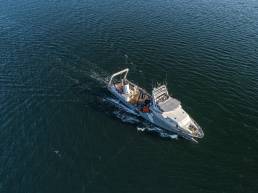
Harmony Link and the Baltic Sea
The Baltic Sea is the youngest sea in the world, and its ecosystem is one of the most unique marine ecosystems on Earth. It is relatively small, almost closed (blind), and shallow in the northern latitudes of the Atlantic Ocean. It has an area of 386 000 square kilometres and a maximum depth of 459 m (average depth is 86 m).
Biodiversity in the Baltic Sea is low compared to other seas or waters. It is home to 50-60 species of fish and 4 species of mammals. However, the water is too brackish for many marine species and too salty for freshwater fish.
The Harmony Link project makes every effort to minimize the environmental impact (fauna and flora) and human activities. The cable would pass through different geological formations on the Baltic seabed: a coastal submarine slope covered with sand and a moraine eroded plain (relict plateau) covered with boulders, shingle, shingle, gargoyle, sand, and morainic clay.
In the context of the principles of integrated maritime planning, the areas with the most negligible impact on the natural environment and other economic activities have been selected. Surveys are being carried out to minimize negative impacts on the seabed, and, if possible, the route of the link will be adjusted to avoid protected seabed habitats.
Seabed surveys are an essential step in the preparatory work for the new electricity interconnector. The surveys will provide the necessary information for the construction and protection of the interconnector cable. In addition, an environmental analysis was carried out to assess the biotic and abiotic conditions of the Baltic Sea in the vicinity of the project.

